Physical Address
304 North Cardinal St.
Dorchester Center, MA 02124
On completion of this chapter, you should be able to:
Describe the sonographic technique to image the neonatal and infant spinal column
Describe the sonographic appearance of normal anatomy of the spinal cord, the dura, the nerve roots, and the cauda equina
Describe how to determine the level of the lumbar vertebrae in the sonographic examination
Describe the different clinical presentations associated with a tethered cord
List the common pathologic conditions of the spinal cord and their sonographic appearances
The spinal canal and its contents can be demonstrated sonographically with great clarity in the neonatal and early infant periods. Thus, high-resolution sonography of the spine has emerged as a widely used first-line clinical tool to detect certain congenital conditions, such as a tethered spinal cord .
Sonography is used to determine the relationship of abnormal clinical findings to deformities in the spinal canal. The infant may present with a sacral dimple or defect anywhere along the posterior surface of the body adjacent to the spinal canal. Although it is not uncommon for the buttocks to contain a shallow dimple near the anus, at times, the dimple appears unusually deep or asymmetric. This may suggest the possibility of an underlying maldevelopment of the spinal column. If these abnormalities are not recognized early, the patient may have difficulty walking or experience other neurologic problems in infancy and childhood.
Advantages of sonography include performing the procedure easily, dynamically, and at the bedside without ionizing radiation. The availability of high-frequency transducers now leaves operator inexperience as the main reason for unsuccessful neonatal spinal sonography. The sonographer may observe the spinal cord as it pulsates normally within the spinal canal, and the vascular supply to the canal may be evaluated with color Doppler. The development of fluid collections, cysts, or fatty tumors (lipomas) may be seen. Malformations of the spinal cord may be imaged and will be presented in this chapter.
The fetal central nervous system begins developing in the first 3 to 4 weeks of the embryonic period. The ectoderm, or outer layer of the trilaminar embryonic disk, gives rise to the neural tube and subsequent spinal cord and brain. During neurulation or neural tube development, the ectoderm differentiates into the neuroectoderm, forming the neural plate posteriorly. The neural plate then wraps in on itself and fuses at the dorsal midline forming the neural tube. Simultaneously, the neural tube separates from the outer ectoderm and sinks below the mesoderm, or middle embryonic layer. The mesoderm, which forms the bony spine, meninges, and muscle, comes to lie between the neural tube and the outer cutaneous ectoderm.
Defects of the spinal canal may occur at any time during these first 8.5 weeks of development. Failure of the neural tube to fold and fuse in the midline results in neural tube defects, such as spina bifida. Failure of the neural tube to completely separate from the outer ectoderm may result in cord tethering, diastematomyelia , or a dorsal dermal sinus. Finally, if the cutaneous ectoderm prematurely separates from the neural tube, it may result in the formation of abnormal mesenchymal or primary mesodermal elements, such as lipomas, between the neural tube and skin.
The vertebral column extends from the base of the skull to the tip of the coccyx along the posterior surface of the body and serves as its central bony stabilizer. Within the vertebral cavity lie the spinal cord, the roots of the spinal nerves, and the covering meninges, all bathed in cerebrospinal fluid (CSF). The meninges and CSF protect the vertebral column. The vertebral column consists of 33 vertebrae: 7 cervical, 12 thoracic, 5 lumbar, 5 sacral (fused to form the sacrum), and 4 coccygeal (fused to form the tailbone) ( Fig. 29.1 ). The pads of fibrocartilage, called intervertebral disks, are found between each vertebra and allow flexibility in the spine.
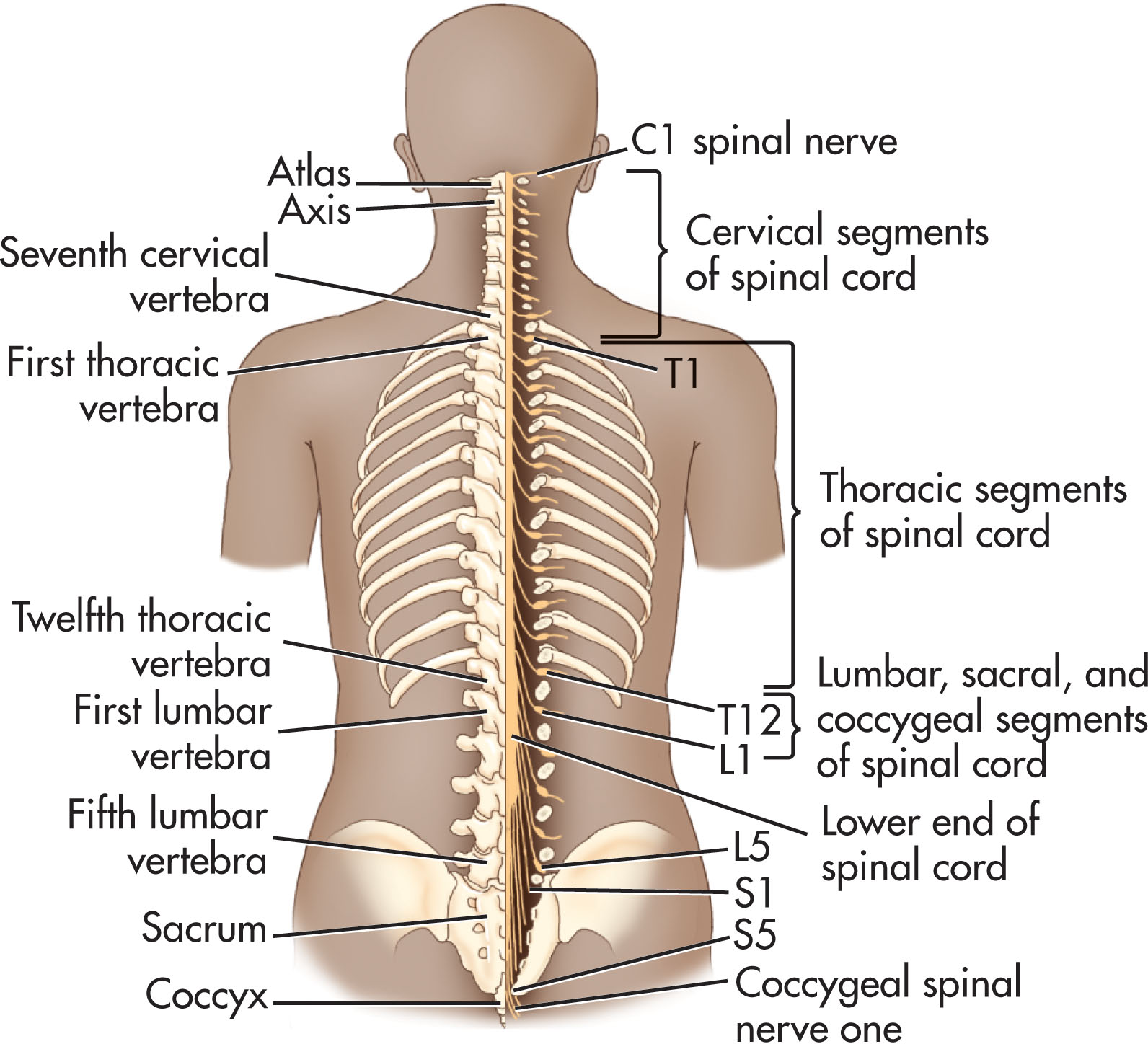
Each vertebra consists of a rounded body anteriorly and a vertebral arch posteriorly ( Fig. 29.2 ). These enclose a space called the vertebral foramen , through which the spinal cord and its coverings run. The vertebral arch consists of a pair of cylindrical pedicles, which form the sides of the arch, and a pair of flattened laminae, which complete the arch posteriorly. The vertebral arch gives rise to seven processes: one spinous, two transverse, and four articular. The two superior articular processes of one vertebral arch articulate with the two inferior articular processes of the arch above, forming two synovial joints.
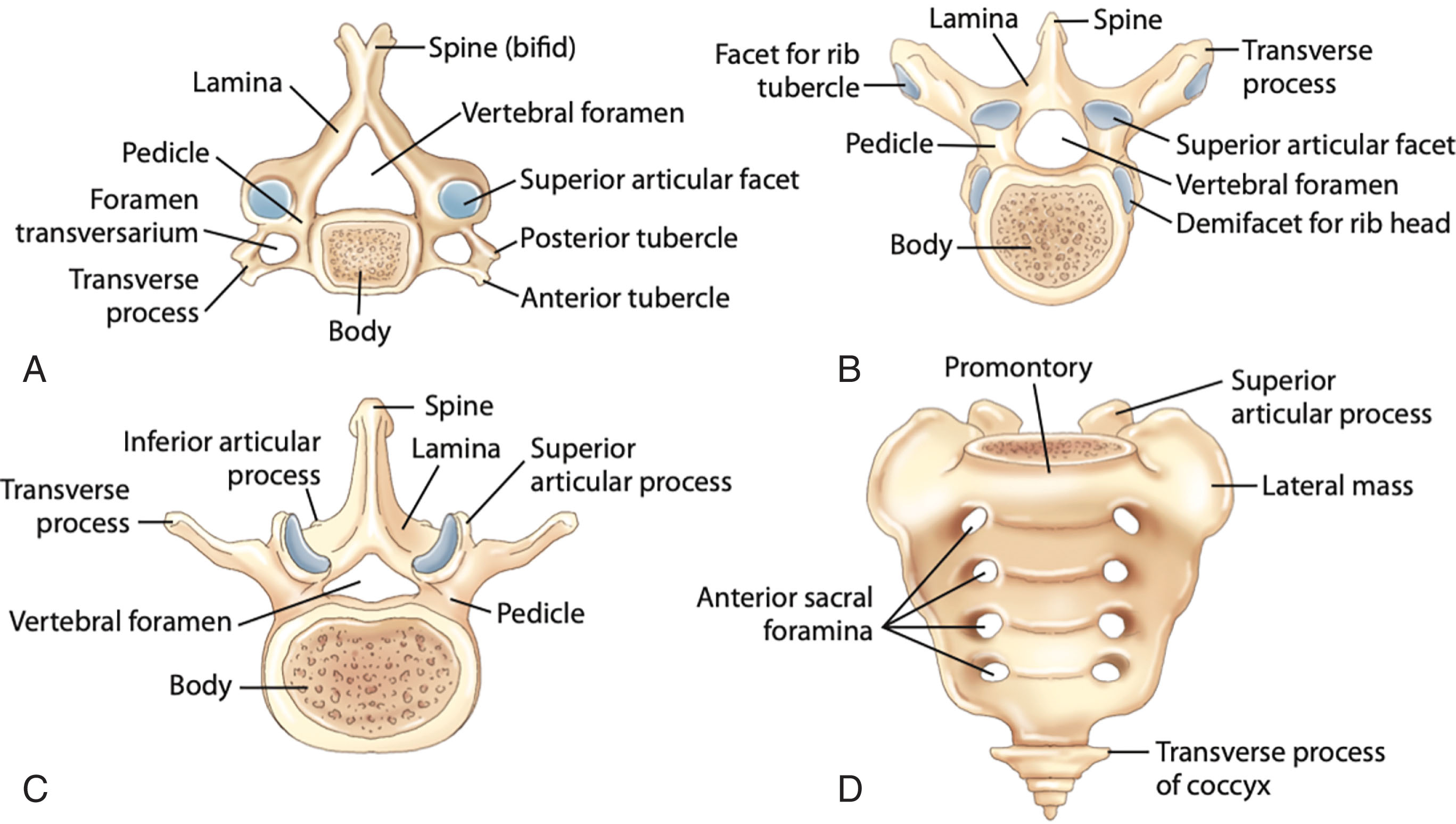
The pedicles are notched on their upper and lower borders, forming the superior and inferior vertebral notches. On each side, the superior notch of one vertebra and the inferior notch of an adjacent vertebra together form the intervertebral foramen. These foramina transmit the spinal nerves and blood vessels.
In the neonate, problems typically occur in the lower back near the area of the lumbar vertebrae and the sacrum. Characteristics of the lumbar vertebrae include a large and oval body, strong pedicles directed posterior, and thick laminae with a triangular vertebral foramen. Additionally, the transverse processes are short, flat, and project backward.
The sacrum consists of five bones fused together. The upper border articulates with the fifth lumbar vertebra. The narrow inferior border articulates with the coccyx. Laterally, the sacrum articulates with the two iliac bones to form the sacroiliac joints. The anterior and upper margin of the first sacral vertebra bulges forward as the posterior margin of the pelvic inlet and is known as the sacral promontory.
The vertebral foramina are present and form the sacral canal. The laminae of the fifth sacral vertebra (and occasionally the fourth) do not fuse at the midline, forming the sacral hiatus. The sacral canal contains the anterior and posterior roots of the sacral and coccygeal spinal nerves, the filum terminale , and fibrofatty material. It also contains the lower part of the subarachnoid space, where the dural or thecal sac ends at the second sacral vertebra ( Fig. 29.3 ).
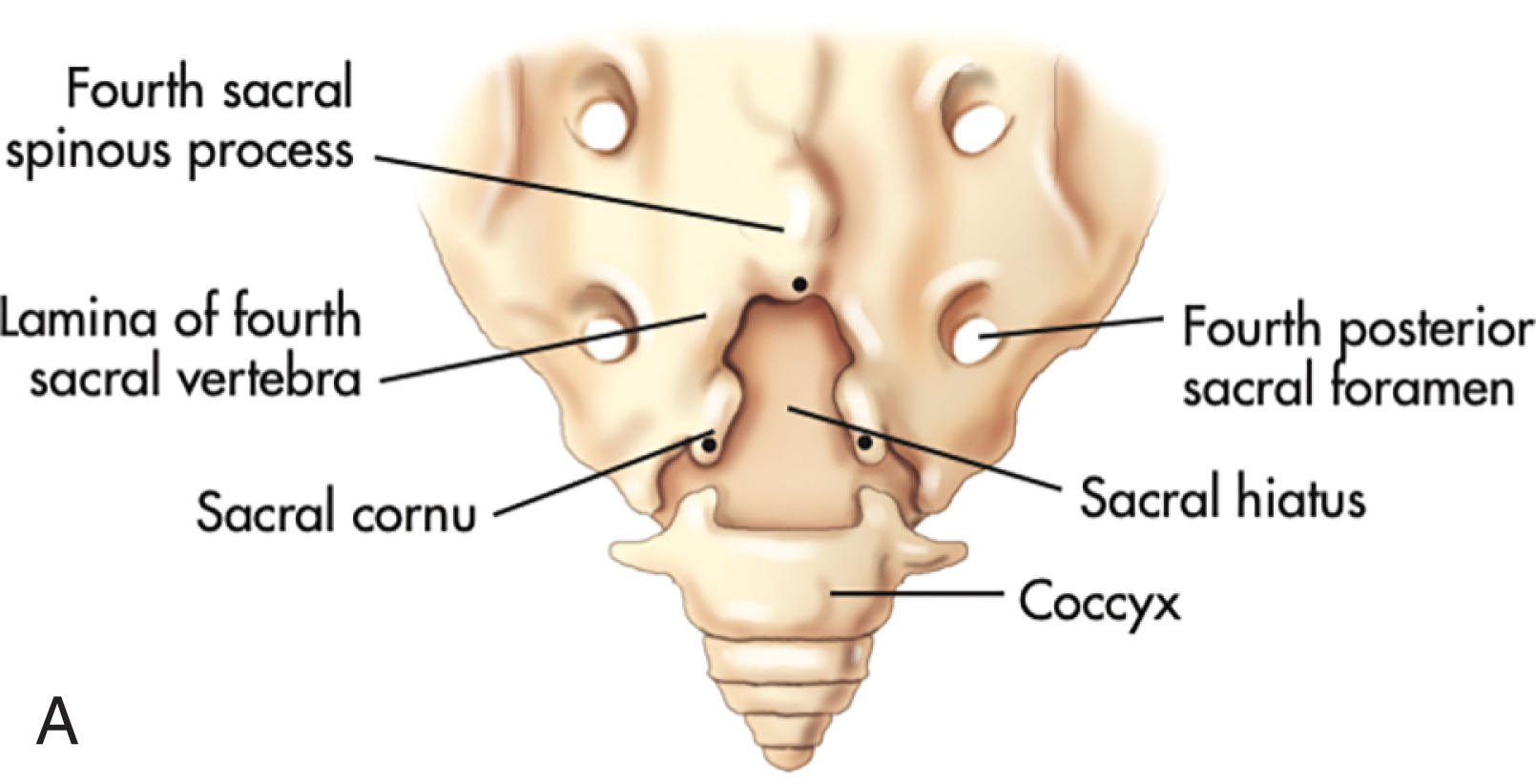
The intervertebral disks make up one-fourth of the length of the vertebral column. They are thickest in the cervical and lumbar regions, where the movements of the vertebral column are greatest. Each disk consists of a peripheral part, the annulus fibrosus, and a central part, the nucleus pulposus ( Fig. 29.4 ). The annulus fibrosus consists of fibrocartilage. The nucleus pulposus is an ovoid mass of gelatinous material containing a large amount of water, a small number of collagen fibers, and a few cartilage cells.
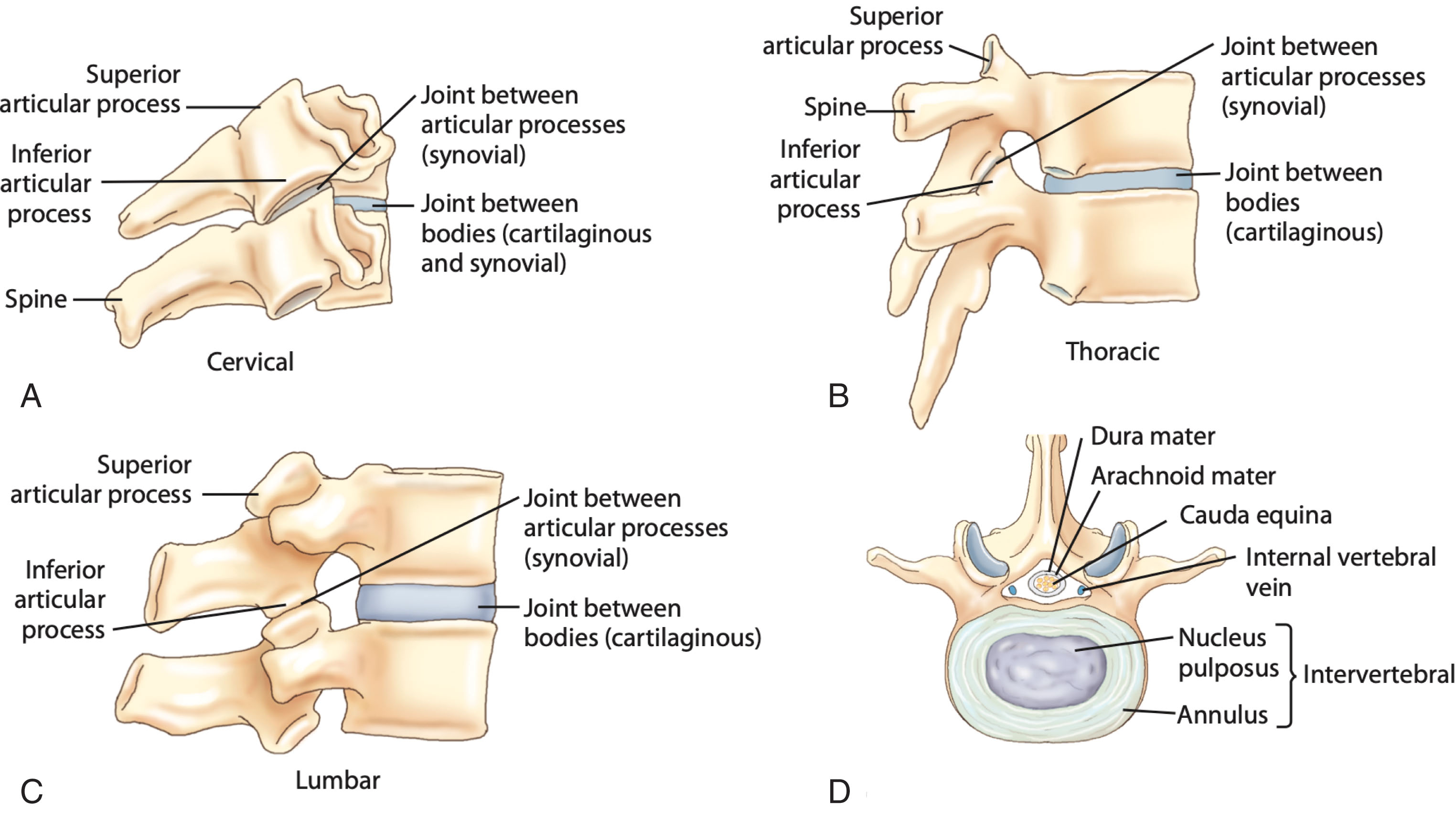
The anterior and posterior longitudinal ligaments run as continuous bands down the anterior and posterior surfaces of the vertebral column from the skull to the sacrum. Transverse dentate ligaments extend laterally from the spinal cord. The small meningeal branches of each spinal nerve innervate the joints between the vertebral bodies.
The spinal cord is a cylindrical, grayish-white structure that begins superiorly at the foramen magnum, where it is continuous with the medulla oblongata of the brain. The cord has a deep longitudinal fissure in the midline anteriorly. The size and shape of the spinal cord vary along its length. Its diameter is narrowest in the midthoracic and thoracolumbar junctions. Inferiorly, the cord tapers off into the conus medullaris , where it ends at its tip.
In the adult, the tip of the conus medullaris terminates below the level of the lower border of the first lumbar (L1) vertebra. At birth, the conus tip may end between the L2 and L3 vertebra, but often it does not extend beyond the second lumbar vertebra. The conus may end even lower, between L2 and L4, in the preterm infant. By 3 months of age, the tip of the conus is at the L1 to L2 level. From its apex, the filum terminale, a thin fibrous cord, descends to be attached to the back of the coccyx to provide stability to the spinal cord ( Fig. 29.5 ).
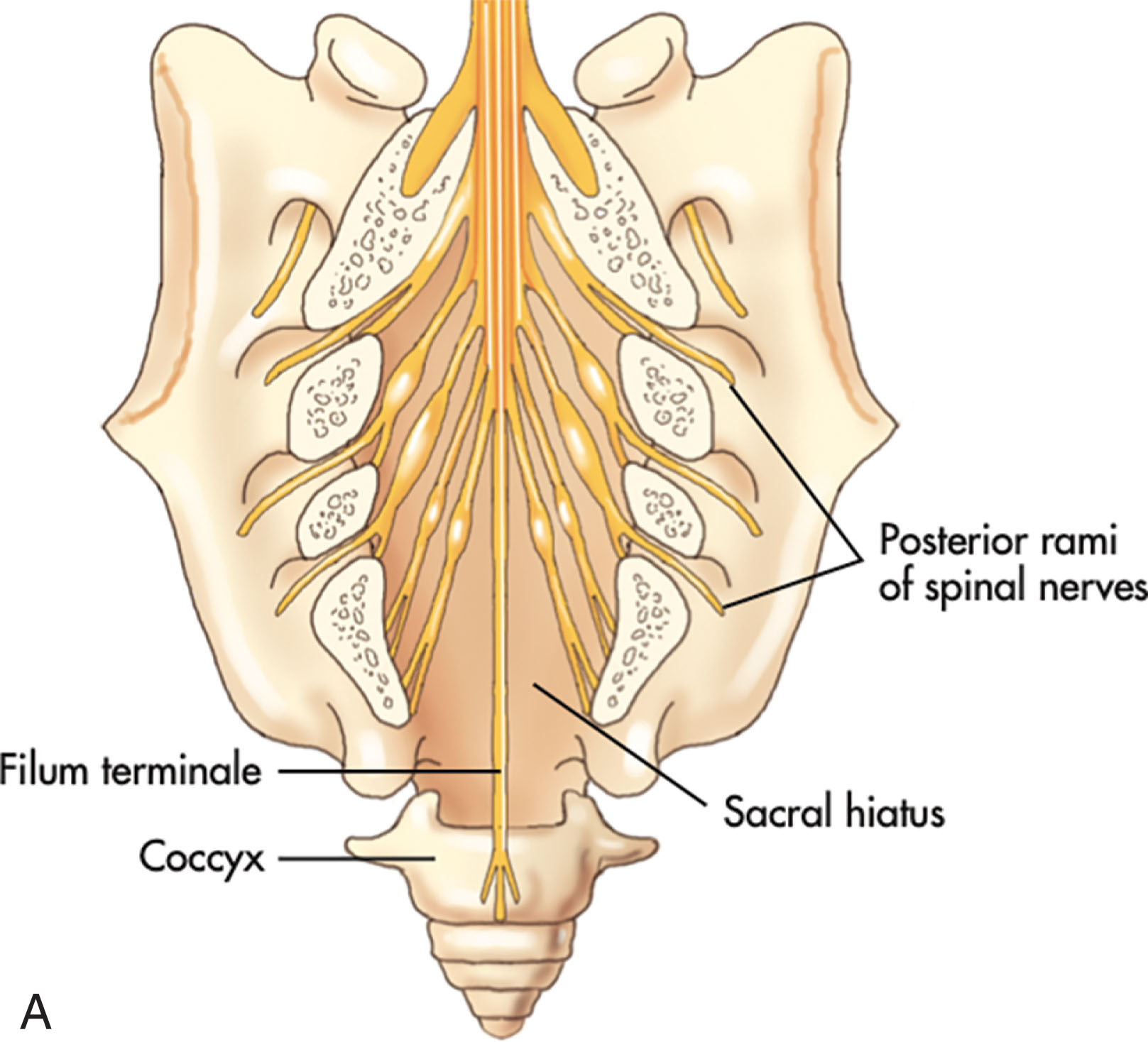
Along the length of the spinal cord are attached 31 pairs of spinal nerves. Each spinal nerve root connects to the central spinal nerve by one dorsal root (carrying sensory fibers to the cord) and one ventral rootlet (carrying sensory fibers away from the cord). The lower nerve roots typically project from the segments lower than L1 to L5 and collectively are called the cauda equina (Latin for “horse’s tail”) (see Fig. 29.5 ).
The spinal cord is surrounded by three meninges: the dura mater, the arachnoid mater, and the pia mater. The dura mater is the most external membrane and is a dense, strong, fibrous sheet that encloses the spinal cord and cauda equina. Collectively, the lowest portion containing CSF is called the thecal sac, or dural sheath, located inferiorly as the lower border of the second sacral vertebra. Superiorly, it is continuous through the foramen magnum with the meningeal layer of dura covering the brain. The arachnoid mater is a delicate impermeable membrane covering the spinal cord and lies between the pia mater internally and the dura mater externally. It is separated from the dura by the subdural space, which contains a thin film of tissue fluid. The arachnoid is separated from the pia mater by a wide space, the subarachnoid space, which contains cerebrospinal fluid. The pia mater is a vascular membrane that closely covers the spinal cord. It is continuous above the neck, through the foramen magnum, with the pia covering the brain. Inferiorly, the pia mater fuses with the filum terminale (see Fig. 29.5 ).
With sonography, the hypoechoic spinal canal is demarcated by the posterior elements anteriorly and the echogenic anterior vertebral bodies posteriorly. In the sagittal plane, scanning directly over the incompletely ossified posterior spinous processes, they will look, individually, like an echogenic upside down U. It should be noted, the tips of the posterior spinous processes are cartilaginous, being a secondary ossification center, and appear hypoechoic in infancy ( Fig. 29.6A ). Laminae are seen when scanning slightly off midline and appear more flat, similar to overlapping roof tiles (see Fig. 29.6B ). In the transverse plane, scanning over the unossified cartilaginous midline tips of the posterior spinous process allows for better visualization ( Fig. 29.7 ).
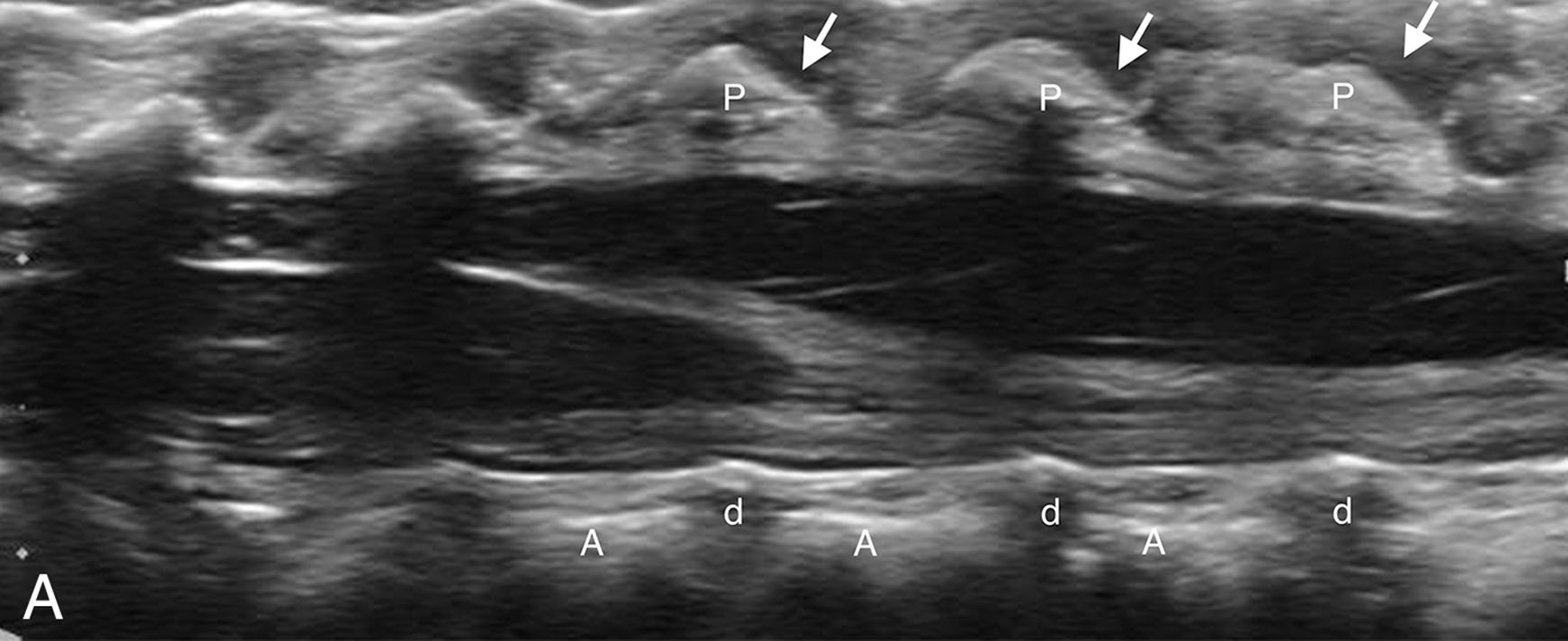
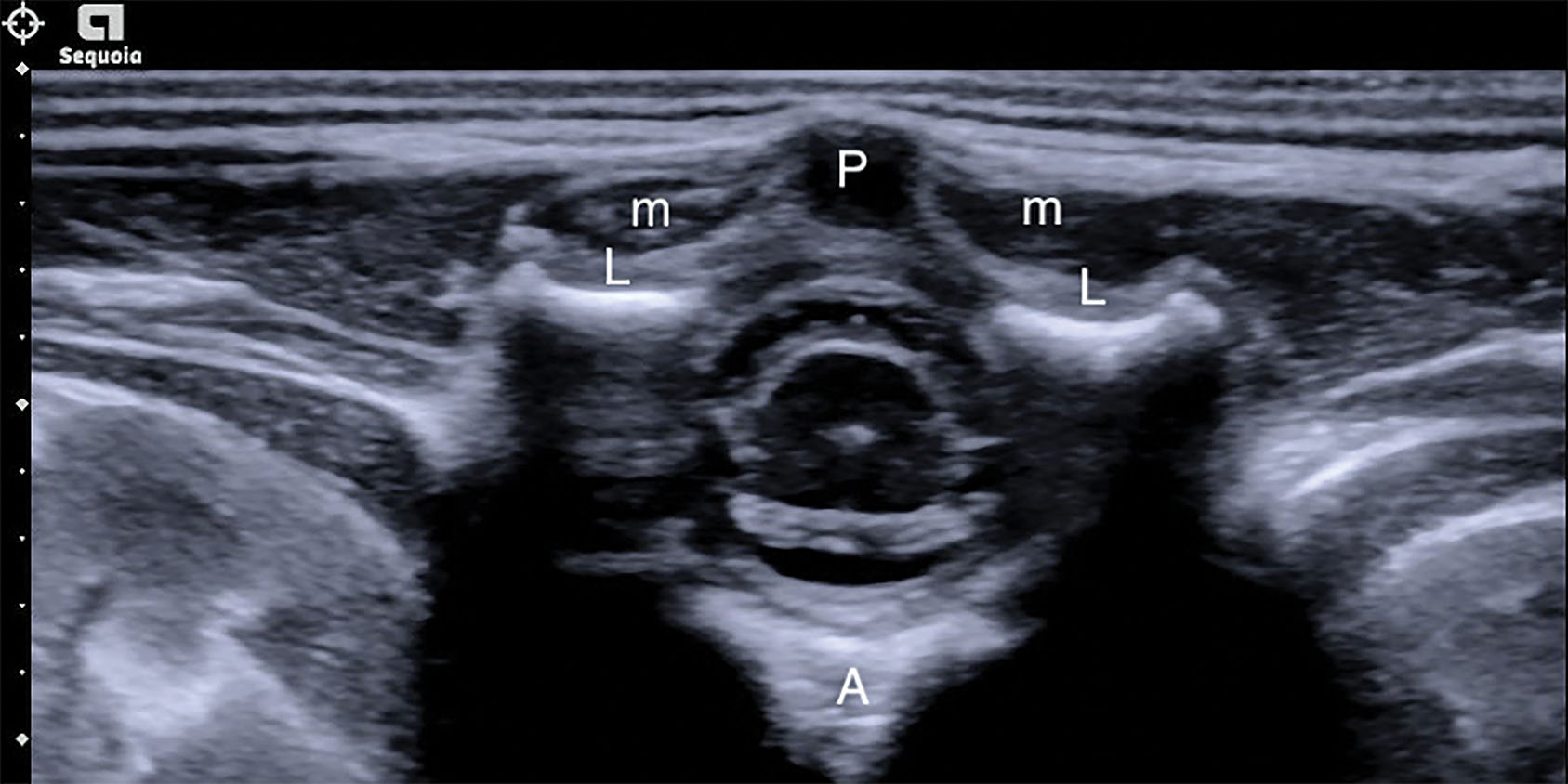
The spinal cord is surrounded by cerebrospinal fluid and appears hypoechoic with slightly echogenic borders and an echogenic line extending longitudinally along its midline. This central echo complex represents the cord’s central canal ( Fig. 29.8A ). The cord’s anterior longitudinal midline fissure may be seen on a transverse image. The spinal cord should taper at its end, called the conus medullaris.
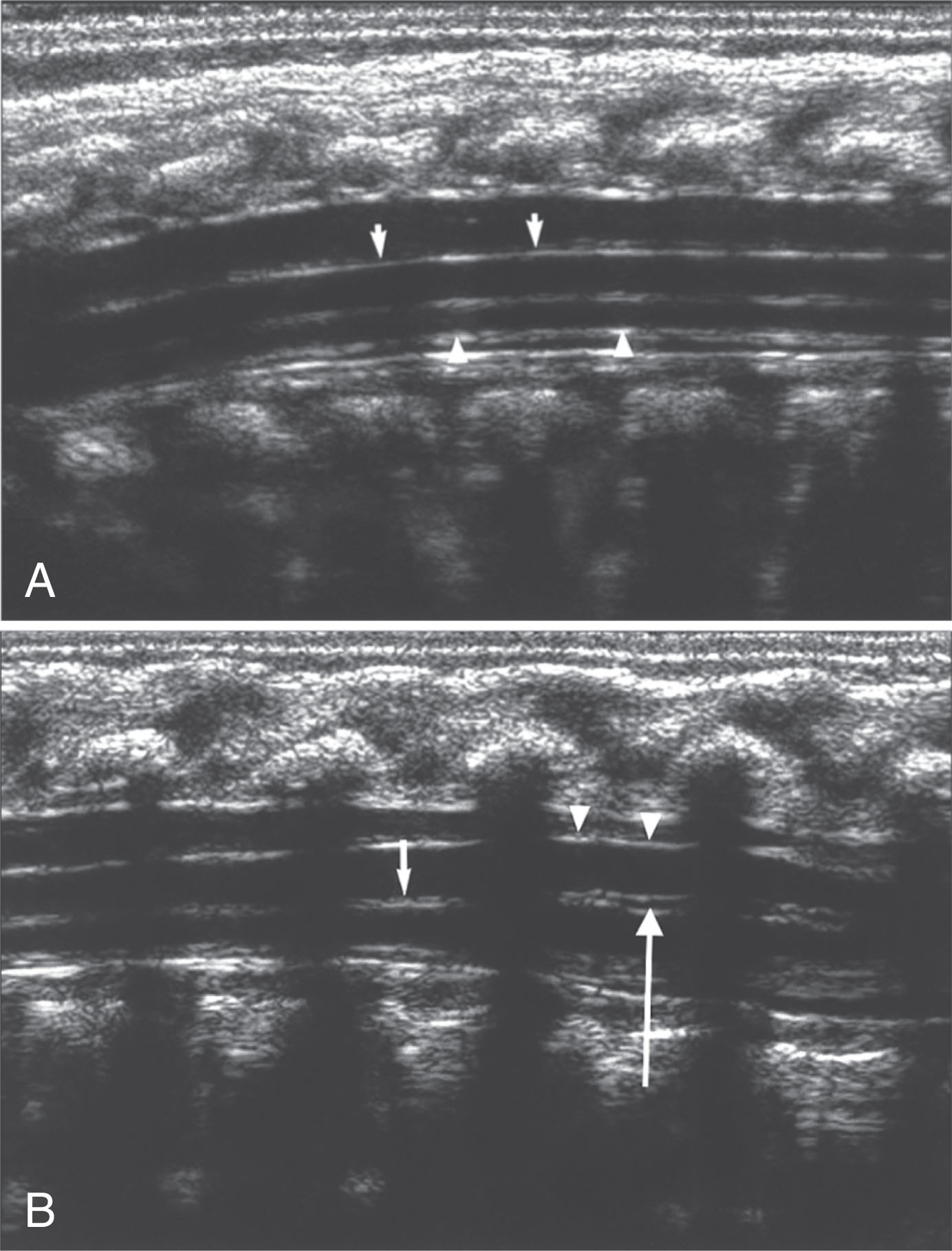
A slight anechoic prominence or widening of the central canal at the caudal end of the cord is a common finding in neonates. This normal variant is often called ventriculus terminalis, also referred to as the fifth ventricle , and it typically disappears within the first few weeks of life ( Fig. 29.8B ). In neonates, this widening is no more than 2 to 4 mm in a transverse diameter and extends longitudinally for 8 to 10 mm. It should be closely investigated to rule out an abnormal cavity, or syrinx, within the canal.
Nerve roots that surround the spinal cord are echogenic and form the cauda equina. They are especially noticeable at and below the conus medullaris. Dorsal and ventral nerve roots can have a spider-like configuration at the tip of the conus in the transverse view ( Fig. 29.9 ). They may also appear as an echogenic clump in the middle of the spinal canal or as bilateral clusters, sometimes in an upside-down V configuration.
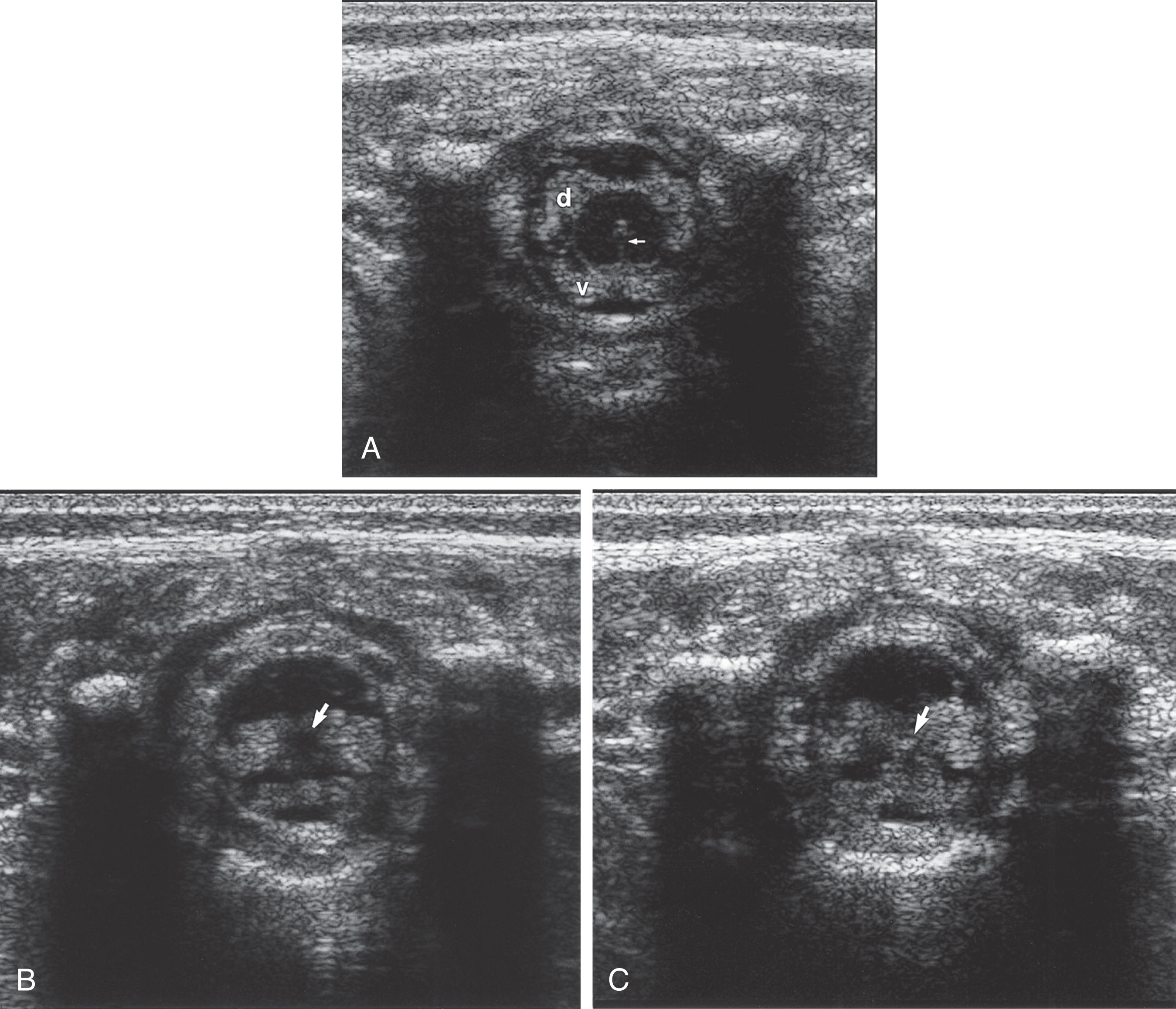
Become a Clinical Tree membership for Full access and enjoy Unlimited articles
If you are a member. Log in here